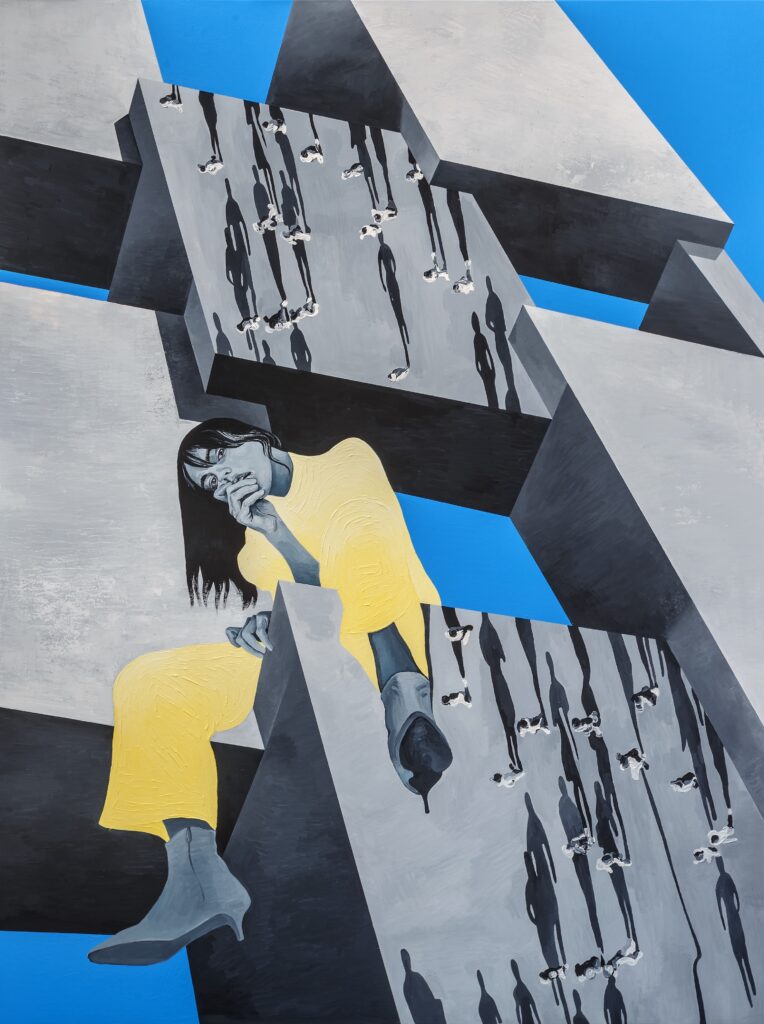It is the work of Moldavian artist Irina Greciuhina that wins the new free-theme competition of ‘Move … in Colors’, an event to celebrate the first year of the Association and its activities in collaboration with the Facebook page ‘Unite the Arts’.
“My blue heaven” is an acrylic on canvas where every element – the brushstroke, the composition, the preparatory drawing – is expressed with great confidence and technical mastery. A bold perspective that leads the observer towards a luminous and symbolic sky, a woman’s body treated as a warm shade of yellow, an anatomy of unnatural colours that nevertheless maintains a throb of life in the nervous gesture of the hands, in the proud and direct gaze. Irina Greciuhina, internationally appreciated and present at the Chisinau Biennial in the 2019 and 2021 editions, achieves a truly interesting result with ‘My blue heaven’. The observer is disoriented by the reversal of spaces: in two of the perspective elements, the grey field is dotted with brush strokes that the long shadow of a setting sun reveals to be people seen from above, people moving frantically in a large empty space. The zenith vision is logical, coherent, unexceptionable: its use in the composition does credit to art as a place of the imagination, with a dreamlike force that has the precision of memory and the absolute freedom of the creative gesture. One is led to turn the painting over, to bring back to normality the stroll on this crowded square, and the work nevertheless maintains a solid balance: the woman’s gaze continues to follow us, triggering an enthralling spiral of glimpses and emotions. “My blue heaven” belongs in its own right to the great European figurative tradition: the perspective, the attention to the body, the chromatic balance that recalls the discoveries on primary colours made by the Avant-gardes in the early 20th century, the skilful use of Baroque perspective that freed the domes of many churches and the ceilings of aristocratic palaces from architectural rigour. What makes the work even more significant is the artist’s ability to present the body of a contemporary woman to the eye as a canon of beauty: slender and with loose hair, sitting informally, with forms that do not linger on femininity. The elegant accessories indicate a serene yet uninhibited self-awareness.
Among the dozens of works in the competition, I indicate nine others, all of particular interest; the theme, in fact, left everyone complete freedom in presenting themselves. I therefore assessed them for technical refinement, for compositional balance, for the elegance that distinguishes between a simple voluntary sign and the artist’s ability to create a visual language.
“The road to monastery” by the Georgian Martin Ashkhatoevi is a fine work of carving on photographic paper: the colours derive from chromatic planes carved with precise blade strokes. A landscape of wilderness that can extend to infinity, a point of arrival barely hinted at, a believer walking to reach the true light.
“Friendly Conversation” a mixed technique by the Indian Mahima Gupta brings the roots of her own tradition into the contemporary, maintaining a dynamic geometric rigour in the composition and almost expressionist elements: the warm colour links the elephants to the earth, the cold ones mix the birds with the sky.
“Blue Worlds” by Mexican Alejandro Vega Gaona reflects on ancestral form and physical movement. An artist who moves from painting to photography and digital, he manages to evoke a drop, the tension of the passage from one body to another, a physical movement made up of silences. The blue accentuates the spiritual dimension.
“Mother” by Iranian Raham Nikbakht is an acrylic that brings the sophistication of the miniature to the canvas, using geometry to create time windows on the same subject. A multitude of flowers frames and encloses a breath of winter, warmed by contrast by the warmth of a mother’s embrace.
“Dance of Nature” – also by Raham Nikbakht – is a gouache, i.e. a covering tempera because it is mixed with a white pigment. The subject reflects this impasto: festoons of flowers, trees and rocks from whose tormented form come out still and unexpected faces. Human generations and life force in one large body.
“El mapa secreto del imperio” (The Secret Map of Empire) by Arquimides Gonzàles Loyola is Cuban art: it retains the monumental structure of the great social compositions and the passionate sensuality of the Latin world. New sartorial myths and an opulent elegance emerge from the play of transparencies, from the secret planes of individuality.
‘Nido de amor’ another work by Arquimides Gonzàles Loyola is a large tripartite acrylic. In contrast to the triptychs, the figuration does not coincide with the limits of each module, but overflows and invades an everyday life made up of symbols and gestures. A carnal passion that unites bodies and becomes a dominant and propulsive force in the world.
“Great Future” is an acrylic by Tendai Makufa, an artist born in Zimbabwe, who controls the bursting of colours through a sharp, dark grid, giving the work the luminosity of a stained-glass window. Crowds of farmers, markets and women engaged in everyday life break up in a big collective dance.
“Solitudini” by the Italian Pio Pellegrini transforms fluid brushstrokes into matter: a primordial clay with which to model the archetypes of couples and society. Creative and painful closure of the male principle set against the welcoming female serenity, in a tight dialogue with no possibility of encounter.
By :MASSIMILIANO REGGIANI
with the collaboration of Monica Cerrito

